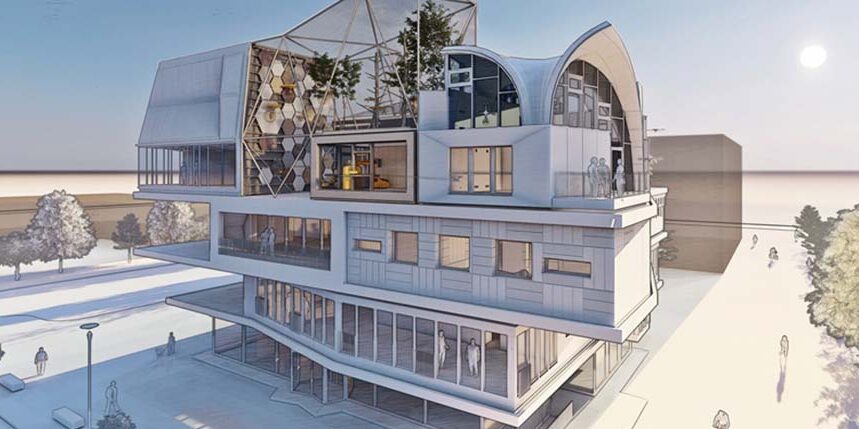“co-operate” – a model for climate-friendly construction

The future campus of Empa and Eawag is nearing completion; it is intended to become an inspiring space for new ideas and innovations, also with a view to environmentally and climate-friendly construction of the future. The buildings and facilities are full of ideas for saving or generating energy and extracting raw materials for later use - from the depths of the subsoil to the roofs.
As far as the sparing use of resources and the reduction of CO2 emissions are concerned, the campus that is taking shape on the Empa site in Dübendorf should certainly become a model student – from the top to the bottom, from the roofs to a depth of 100 metres, where the earth probes of a unique experimental seasonal energy storage system end. In summer, these “tubes” will store the waste heat from, for example, the refrigeration machines, ventilation systems and laboratory equipment, and then use it in winter for heating or for the production of hot water. The goal: to reduce the CO2 emissions of the buildings on the entire campus to a minimum and at the same time explore this innovative technology for a sustainable energy future.
Minimising greenhouse gas emissions: This aspiration also shapes the constructions of the new campus. The three-storey building to the right of the entrance is a unique “wood-concrete car park” whose ceilings are a sophisticated construction of spruce beams and slabs with concrete overlay. According to the construction company Implenia, this hybrid construction method made it possible to reduce the thickness of the concrete layers to about one third. A significant saving was made on the “climate polluter” cement: around 9,300 m2 of concrete ribbed ceilings were replaced with wooden beam ceilings – also a contribution to the current trend of replacing concrete, where possible and sensible, largely with constructions made of wood.
According to Kevin Olas, Head of Real Estate at Empa, one of the challenging aspects of this project was the cleverly integrated installation of lighting, electrical lines and waste water pipes, so as not to detract from the aesthetics of this sophisticated hybrid construction. In addition, the planning also had to take future aspects into account: With a view to climate change, the multi-storey car park was planned as a modular construction made of demountable prefabricated parts – with a view to a more distant future in which individual mobility may play a lesser role than it does today. Then parts of the building could also be converted into workshops or for other purposes.
Urine as raw material for fertiliser
In this future, environmentally friendly recycling will also determine building: Not only steel, concrete or wooden elements can be recycled in a climate-friendly way, but also human “raw materials”. Take urine, for example: in the large laboratory building at the centre of “co-operate”, “NoMix” toilets have been installed, which experts from the Eawag Water Research Institute have developed over the past few years. Without changing the usual use, they separate human urine from the so-called black water from faeces, flushing water and toilet paper.
Because urine contains valuable nutrients such as nitrogen, phosphorus and potassium, it can be used to produce fertiliser for agriculture. In a process specially developed by Eawag, the raw material is first stabilised in the basement of the NEST building using a biological process, thus losing its strong odour. An activated carbon filter removes all drug residues before the liquid is finally evaporated – to produce a high-quality fertiliser called “Aurin”, which is marketed by the Eawag spin-off Vuna GmbH. 1000 litres of urine produce 100 litres of this fertiliser, which since 2018 has also been approved by the Federal Office for Agriculture for use on edible plants.
Many mosaic stones for a good carbon footprint
In addition to the inconspicuous urine collection system, many obvious details document the campus’ claim to be a signpost for environmentally friendly construction. Photovoltaic installations will massively increase the campus’ own electricity production. And on more than 14,000 m2 of floor space, people move on recycled asphalt with a high proportion of 80 percent recycled material in the base layer and 20 percent in the thin surface layer.
At the same time, the landscape architects have freely dispensed with asphalt in order to design close to nature: Previously sealed areas are “liberated”, such as Ludwig-Tetmajer-Strasse on the Empa site. “This ‘car park asphalt desert’ will become a green and shady zone,” explains Kevin Olas. And behind the large new buildings, biodiversity is also being promoted with diverse plants and trees – thanks to selected heat-resistant species that will also feel at home in future climate conditions.